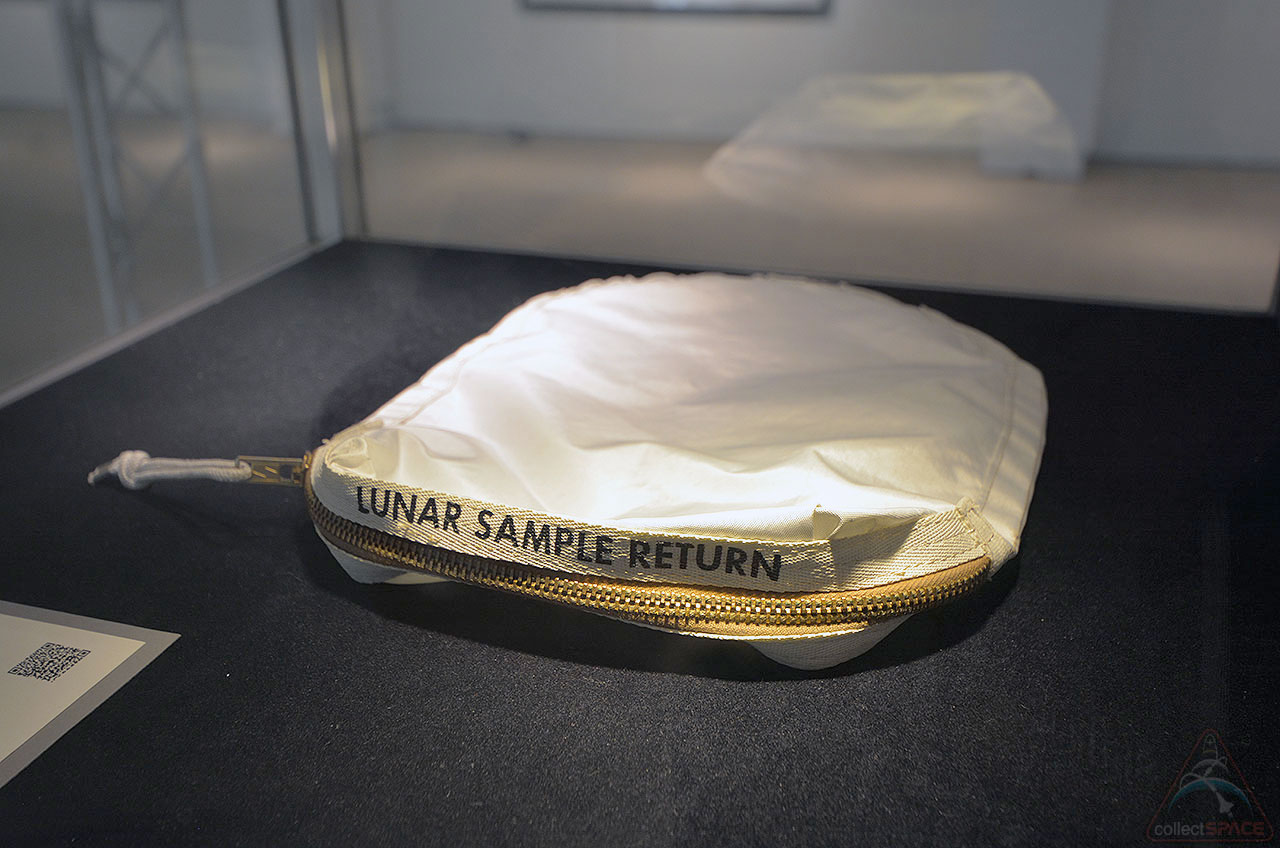Law firm claims stake in tape strips used to lift moon dust off Apollo 11 sample bag
The saga continues.

A Kansas City law firm has filed suit over what it claims is its financial stake in five small strips of possibly-moon-dust-stained carbon tape, extending an already complicated — and, at times, convoluted — legal saga that has surrounded a white zippered pouch that was used on the first moon landing mission 51 years ago.
The defendant, an Illinois real estate attorney who sold the Apollo 11 lunar sample return bag for $1.8 million, succinctly characterized the situation in the first line of a court filing with regard to the law firm of Wyrsch Hobbs Mirakian (WHM) and its attempt to enforce a lien on the tape strips.
"The story underlying this matter and other related litigated matters is long," the attorneys for Nancy Lee Carlson wrote in a motion that was filed with the District Court of Kansas in March.
Lunar legacy: 45 Apollo moon mission photos

Lifting the moon
The case, as first reported by Mike Hendricks for the Kansas City Star, centers on the pieces of tape that were used by NASA to ascertain if the sample bag that Carlson bought for $995 at a U.S. Marshals auction in 2015 had been to the moon in 1969. The pouch had been among the space memorabilia forfeited by a former museum curator, who was convicted of stealing and selling NASA- and museum-owned artifacts.
The tape had been used to lift samples of suspected lunar dust from the interior seams of the bag.
"The particles on one of the test strips were analyzed by NASA and it was confirmed that the bag was an outer decontamination bag used on the Apollo 11 mission to hold the first lunar samples ever collected," Carlson's attorneys wrote, "and that the particles on or in the bag were, in fact, lunar dust."
Get the Space.com Newsletter
Breaking space news, the latest updates on rocket launches, skywatching events and more!
Given the findings, NASA refused to return the bag to Carlson, asserting that it had never relinquished ownership of the artifact. In response, Carlson filed two lawsuits: one in Texas, where the bag was being held at NASA's Johnson Space Center in Houston, and the other in Kansas, where it had been forfeited.
As the cases proceeded, it was revealed that the bag had been incorrectly cataloged, obfuscating that it was still NASA property when it was forfeited as part of a restitution order against the convicted curator. Still, a U.S. district court judge found that because the U.S. Marshals Service had proceeded with the sale and Carlson had made a good-faith purchase, that the bag was no longer NASA's.
After the bag was returned to her, Carlson consigned it to auction. On July 20, 2017, 48 years to the day after it was used by first moonwalker Neil Armstrong, Sotheby's sold the Apollo 11 artifact for $1,812,500 on Carlson's behalf.
A year and a half later, Carlson retained the services of WHM to sue NASA again, this time to be compensated for the bag having been torn during the agency's tests (she claimed the damage had "diminished the fair market value") and for the return of any lunar material that had been removed from the bag. The case was settled out of court, with the government paying Carlson $50,000 and handing her all but the one tape strip it had tested.
28.5%
In retaining WHM, Carlson signed an agreement that included compensating the firm for up to $50,000 of hourly fees and, after that was met, "an amount equaling 28.5% of the net trial award or settlement." Two weeks after settling the case with the government, attorney Stephen Mirakian emailed Carlson to confirm "WHM's entitlement to compensation from any future sale or other disposition of the carbon tapes." He also urged her to have the five tape strips submitted for testing.
"While it is our expectation that some or all of the five carbon tapes have lunar material likely in an amount comparable to the one tape that the NASA test confirmed lunar material, until you have obtained examination of the results from a qualified laboratory, it is difficult to approximate the market value of the tapes or portions thereof," Mirakian wrote in his email to Carlson. "Even if the testing does not confirm the presence of lunar material on any of the tapes, there still might be a marketable value for carbon tapes that were used for examination of an authentic Apollo 11-flown sample containment bag."
The email took Carlson by surprise. "I was not advised at any time that [WHM] would be taking any kind of lien or interest in the tapes, and I never consented to them doing so," she stated in an affidavit. "There was also no dissuasions about the manner in which any of the tapes would be appraised or sold and what would occur if I chose not to sell the tapes."
Carlson claimed that had she known of such an intention, she would not have agreed to the settlement. Further, she believed that all matters relating to her ownership of the strips had been decided by an earlier court case, preceding her retention of WHM.
The Apollo Program: How NASA sent astronauts to the moon
Market for moon dust
Setting aside the lawsuit and without knowing what Carlson has planned for the strips, the tapes now in her possession may be unprecedented in their nature — assuming there are some traces of lunar material on them.
While there have been past sales of tape pieces stained by moon dust, they have fallen into three general categories: legally obtained lunar samples lifted off Apollo-used equipment that was de-accessed by NASA; legal lunar samples lifted off astronaut-owned, flown-to-the-moon mementos; and illegally obtained samples lifted by space program workers who came in contact with dust-stained NASA property and used the tape to collect a souvenir.
NASA has pursued and, in some cases, succeeded in the return of the latter, and investigated the validity of the other two types of dust samples. Carlson's tape strips may be the first to be turned over by the space agency, by settlement, court order or otherwise.
Legally obtained Apollo moon dust-stained pieces have sold in the past for upward of $1,000 per 0.4 inches (1 centimeter) of tape and astronaut-owned flown artifacts dirtied by traces of the moon have been auctioned for hundreds of thousands to millions of dollars.
The population of such samples is low in number, though, with the vast majority of the 842 pounds (328 kilograms) of lunar material collected by the six Apollo moon landing missions still in NASA's control.
Follow collectSPACE.com on Facebook and on Twitter at @collectSPACE. Copyright 2020 collectSPACE.com. All rights reserved.
Join our Space Forums to keep talking space on the latest missions, night sky and more! And if you have a news tip, correction or comment, let us know at: community@space.com.

Robert Pearlman is a space historian, journalist and the founder and editor of collectSPACE.com, a daily news publication and community devoted to space history with a particular focus on how and where space exploration intersects with pop culture. Pearlman is also a contributing writer for Space.com and co-author of "Space Stations: The Art, Science, and Reality of Working in Space” published by Smithsonian Books in 2018.In 2009, he was inducted into the U.S. Space Camp Hall of Fame in Huntsville, Alabama. In 2021, he was honored by the American Astronautical Society with the Ordway Award for Sustained Excellence in Spaceflight History. In 2023, the National Space Club Florida Committee recognized Pearlman with the Kolcum News and Communications Award for excellence in telling the space story along the Space Coast and throughout the world.

